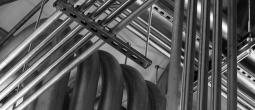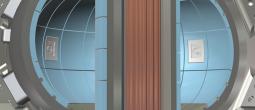

Fusion Reactor Overview

The choice of primary power source was one of the first technology hurdles that the vessel construction program had to overcome. The power requirements of the main engines and superluminal drive required a significant energy source that also did not have prohibitive mass. The power systems aboard captured alien vessels had proven either too damaged or too complex to replicate in any form.
Fusion reactors were the obvious theoretical choice but existing terrestrial technology had never produced a viable reactor. Advanced new materials developed from alien vessels provided the missing piece of the puzzle, allowing construction of reactors capable of maintaining self-sustaining fusion reactions indefinitely.
Reactor Systems
The reactor's central component is a toroidal chamber constructed from heat and radiation-resistant materials. The reaction chamber houses the reaction core, which contains super-heated plasma confined within powerful magnetic fields. A coolant system transfers heat energy from the reactor chamber to a generation turbine system.
The reactor is predominantly a terrestrially-derived design utilizing materials and techniques developed from a number of fusion research programs around the world. Although none of these programs have produced an operational reactor, their design approaches are capable of achieving a self-sustaining reaction when augmented with advanced room-temperature superconducting materials. These superconductors have been developed using quantum-chromodynamic (QCD) technology reverse-engineered from captured alien vessels and produce magnetic fields powerful enough for viable fusion reactors.
Reaction Chamber
The reaction chamber is designed to contain the heat and high-energy neutronic radiation characteristic of fusion reactions. The reaction-facing interior of the chamber wall is shielded with a system of dual-layered modules designed to attenuate most of the heat and radiation load before it reaches the chamber wall. As this shield layer is susceptible to accelerated degradation from neutronic particles, the modules are designed to be easily replaceable using a robotic maintenance system.
Magnetic Containment Field
The magnetic containment field maintains the reaction plasma under extreme pressure, assisting the reaction process and containing the worst of the reaction’s heat energy away from the reaction chamber walls. The containment field is created by a series of superconductor generators surrounding the reaction chamber. The materials making up the generators are unique in having superconducting properties at room temperature, allowing far more powerful magnetic fields and much greater operational stability than would be possible with traditional superconductors.
Coolant System
A pressurized coolant system transfers heat energy from the reaction chamber to the generation turbine system. This process also acts to cool the reaction-facing components of the chamber. The transfer is conducted through a heat exchange interface so that a non-irradiated secondary coolant system supplies the generation turbine. This accommodates the pressure maintenance and venting systems required by the generation system and improves repair and maintenance access.
Reaction Plasma Management
The reactor is fueled by a combination of hydrogen isoptopes which are forced to combine under enormous pressure, creating helium and in the process releasing significant amounts of energy. The fuel isotopes are initially heated to create a low-temperature ionized gas (plasma) which is then subjected to a number of particle excitation techniques to bring it to reaction temperature.
Maintaining a self-sustaining reaction requires careful management of plasma flow which is achieved using secondary magnetic fields. These alter the characteristics of the primary containment field to optimize plasma flow and minimize magnetohydrodynamic (MHD) instabilities, which might otherwise disrupt the reaction and plasma containment.









